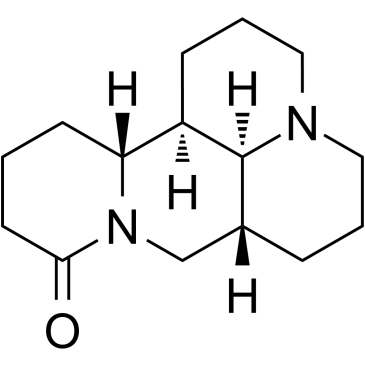Sophoridine
Modify Date: 2024-01-08 11:12:21

Sophoridine structure
|
Common Name | Sophoridine | ||
|---|---|---|---|---|
| CAS Number | 6882-68-4 | Molecular Weight | 248.364 | |
| Density | 1.2±0.1 g/cm3 | Boiling Point | 396.7±31.0 °C at 760 mmHg | |
| Molecular Formula | C15H24N2O | Melting Point | 109 °C | |
| MSDS | N/A | Flash Point | 172.7±17.2 °C | |
Use of SophoridineSophoridine is a quinolizidine alkaloid isolated from leafs of Leguminous plant Sophora alopecuroides.L. Sophoridine induces apoptosis. Sophoridine has the potential to be a novel, potent and selective antitumor drug candidate for pancreatic cancer with well-tolerated toxicity[1]. |
| Name | Sophoridine |
|---|---|
| Synonym | More Synonyms |
| Description | Sophoridine is a quinolizidine alkaloid isolated from leafs of Leguminous plant Sophora alopecuroides.L. Sophoridine induces apoptosis. Sophoridine has the potential to be a novel, potent and selective antitumor drug candidate for pancreatic cancer with well-tolerated toxicity[1]. |
|---|---|
| Related Catalog | |
| In Vitro | Sophoridine (0-500 μM; 48 hours) exhibits remarkable inhibition effects to the growth of human pancreatic, gastric, liver, colon, gallbladder, and prostate carcinoma cells with IC50 values of about 20 μM to 200 μM[1]. Sophoridine (0-20 μM; 48 hours) increases S phase cell population from 26.23% (control) to 38.67% in Miapaca-2 cells and from 29.56% (control) to 39.16% in PANC-1 cells, about a 1.5-fold and a 1.3-fold increase, respectively[1]. Sophoridine (0-20 μM; 48 hours) significantly increases bad and bax levels, and decreases bcl-2 and bcl-xl levels in contrast, with a significant increase in Bax/Bcl-2 ratio[1]. Cell Viability Assay[1] Cell Line: Normal cells: IOSE144, HL-7702 and LO2, BEAS-2B, GES-1, HEK 293 T, HPDE, FHC, Human cancer cells: PANC-1, Mapaca-1, hepG2, SGC-7901, CBC-SD,SGC-996,PC-3,MKN-45,MGC-803,Hela and HCT116 cells Concentration: 0, 3.9, 7.8, 15.5, 31, 62.5, 125, 250, 500 μM Incubation Time: 48 hours Result: Exhibited the most potent cytotoxicity to cancer cells. Cell Cycle Analysis[1] Cell Line: PANC-1 cells; Miapca-2 cells Concentration: 20 μM Incubation Time: 48 hours Result: Led to accumulated population in the S phase. Western Blot Analysis[1] Cell Line: PANC-1 cells; Miapca-2 cells Concentration: 20 μM Incubation Time: 48 hours Result: Induced the activation of intrinsic apoptosis pathway. |
| In Vivo | Sophoridine (intraperitoneal injection; 20 or 40 mg/kg; 21 days) can inhibit the growth of xenograft pancreatic tumors[1]. Animal Model: BALB/c homozygous (nu/nu) nude mice[1] Dosage: 20 or 40 mg/kg Administration: Intraperitoneal injection; 20 or 40 mg/kg; 21 days Result: Decreased xenograft pancreatic tumors mass. |
| References |
| Density | 1.2±0.1 g/cm3 |
|---|---|
| Boiling Point | 396.7±31.0 °C at 760 mmHg |
| Melting Point | 109 °C |
| Molecular Formula | C15H24N2O |
| Molecular Weight | 248.364 |
| Flash Point | 172.7±17.2 °C |
| Exact Mass | 248.188858 |
| PSA | 23.55000 |
| LogP | 1.44 |
| Vapour Pressure | 0.0±0.9 mmHg at 25°C |
| Index of Refraction | 1.581 |
CHEMICAL IDENTIFICATION
HEALTH HAZARD DATAACUTE TOXICITY DATA
|
| 1H,5H,10H-Dipyrido[2,1-f:3',2',1'-ij][1,6]naphthyridin-10-one, dodecahydro-, (7aR,13aR,13bR,13cS)- |
| Allomatrine |
| (5β)-Matridin-15-one |
| Bio-0637 |
| 5-Epidihydrosophocarpine |
| Dihydro-5-episophocarpine |
| (7aR,13aR,13bR,13cS)-Dodecahydro-1H,5H,10H-dipyrido[2,1-f:3',2',1'-ij][1,6]naphthyridin-10-one |
| sophoridine |
| matridin-15-one |

